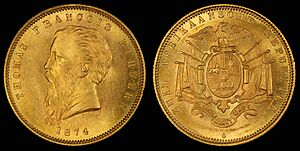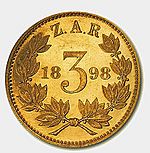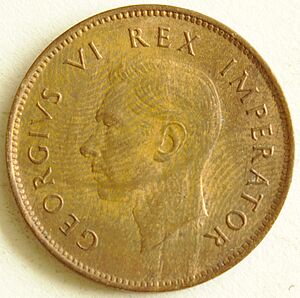Coins of the South African pound facts for kids
The coins of the South African pound were the money used in South Africa a long time ago. Before 1910, different parts of South Africa made their own money. After 1910, most coins were British. But coins from Paul Kruger's South African Republic were still used too.
In 1923, South Africa started making its own coins. These coins were the same size and value as British coins. For example, 12 pence made 1 shilling. And 20 shillings made 1 pound (£1).
On February 14, 1961, South Africa changed its money system. They switched to a decimal currency, which means it was based on units of 10. The pound was replaced by the Rand.
People had a nickname for the 3-pence coin: "Tickey." This name was also used for the new 2.5-cent coin that replaced it.
Contents
How the Pound Came to South Africa
The Cape of Good Hope was a Dutch colony from 1652 to 1795. Then, British forces took control of it. It went back to the Dutch for a short time, but the British took it again in 1806. In 1814, it officially became part of Britain.
After 1806, the British military leader made a rule. He stopped money from leaving the colony. He also set the value for different coins used there. Over the next few years, British coins became more common. By 1826, British money was the only official money in the Cape Colony.
Coins of the South African Republic
The South African Republic (also called ZAR) was a country in South Africa in the 1800s. It later became the Transvaal province. Even though it was mostly independent, Britain had some control over it. This led to discussions about whether its coins were "Commonwealth" coins.
The Burgerspond of 1874
The Burgerspond was the very first coin made for any part of what is now South Africa. It was made in England.
In 1874, the President of the South African Republic, Thomas François Burgers, wanted to make their own coins. He sent gold to London to have coins made. These coins were the same size as the English sovereign. Two groups of these coins were made. The first group had 695 coins and is called the fine beard type. The second group had 142 coins and is called the coarse beard type.
When the first coins (the fine beard type) were shown, some people were upset. They thought it was wrong to have President Burgers' face on the coins. But others were proud to have their own money.
Kruger Coins from 1892 to 1900
In 1885, gold was discovered in the Witwatersrand. This changed the South African Republic from a farming area to a rich mining region. In 1892, President Kruger decided to build a mint and make a full set of coins for the republic.
The government decided to use a money system similar to Britain's. There were 12 pence in one shilling, and 20 shillings in one pond. These coins showed President Kruger's face. The name of the republic, Zuid-Afrikaansche Republiek, was shortened to ZAR on some coins.
The 1892 coins were made in Berlin, Germany. Other coins were made at the South African Republic's own mint in Pretoria.
There are two types of Kruger coins: Single Shaft and Double Shaft. These names come from the wagon shown on the republic's coat of arms. The Double Shaft coins are also called Disselboom, which means "Double Shaft" in Afrikaans. The 1892 Single Shaft pond coin is very rare. The Disselboom coins are the 1892 half-pond and 5-shilling coins. Be careful, as there are fake Disselboom coins. A real Disselboom 5-shilling coin must have wagon wheels that are the same size.
These coins were made while Paul Kruger was President. They show his face on one side and the ZAR coat of arms on the other.
- Penny (1D/pence): Made from 1892 to 1894, and again in 1898.
- Tickey (3D): Made from 1892 to 1897.
- Six Pence (6D): Made from 1892 to 1897.
- Shilling (1S): Made from 1892 to 1897.
- Two Shillings (2S): Made from 1892 to 1897.
- Half Crown (2.5S): Made from 1892 to 1897.
- Crown (5S): Only made in 1892, with both single and double shafts.
- Half Pond (£1/2): Made from 1892 to 1897.
- Pond (£1): Made from 1892 to 1902.
- Blank Pond (£1): Made in 1900, with or without a rim.
- Veldpond (£1): Only made in 1902.
In 1899, a pond coin was not made because the tools for making them were stopped by the British. Instead, the Boer government used 1898 tools and stamped a "9" on the coin to show it was 1899. Only one such coin, called the "Single 9," was made. Another 130 coins were stamped with two smaller "9s" and are called the "Double 99."
The Sammy Marks Tickey of 1898
This coin is very rare. It looks like the Tickey from 1892–97 but is dated 1898. It was made from 22-carat gold. Only 215 of these coins are known to exist. They were made by a rich mining owner named Sammy Marks. There were also copies made by jewelers at the same time. These jeweler copies are also gold. You can tell them apart because the jeweler copies do not have dots in the "Z.A.R." on the back.
The Veld Pond and the Kaal Pond
The Second Anglo-Boer War started in October 1899. In June 1900, the British took over Pretoria, the capital of the South African Republic. When the British were about to enter Pretoria, the Boer Government left. They took all the valuable metals from the Pretoria Mint with them. Among these metals were some pond coins that were ready to be stamped. These were put into use and became known as kaal ponde (which means "naked pounds").
The government then set up a temporary mint in Pilgrim's Rest. There, 986 Veld Ponde were made and used. These coins were made with tools created by hand. They had the South African Republic's initials Z.A.R and the date (1902) on one side. On the other side, they had the words EEN POND (one pound).
Kruger Pond Brass Token
There is a brass token that looks like the Kruger 1-pond coin. But it's not a real coin. You can tell by looking at the scroll under the coat of arms. Instead of the usual words, it says 'IMITATION KRUGER SOVEREIGN'.
Coins of the Union of South Africa
From 1923, coins for the Union of South Africa were made at the Royal Mint in Pretoria. In 1941, the South African government took over the mint. It was renamed the South African Mint. It kept making coins similar to British ones for some years.
King George V Coins (1923–1936)
These coins featured the portrait of King George V. The 2-shilling coin was made during both the first and second periods of his coinage.
- Smallest coins: 1⁄4d and 1⁄2d.
- Penny (1d).
- Tickey (3d), Six Pence (6d), Shilling (1/-), Two Shillings (2/-), Half Crown (2/6).
- Gold coins: Half sovereign and 1 sovereign. These were like British ones but had an 'SA' mark.
The designs on the back of most coins from 1925 onwards were created by George Kruger Gray.
King George VI Coins (1937–1952)
These coins showed King George VI without a crown, designed by T. Humphrey Paget. The designs on the back by George Kruger Gray were mostly continued. However, the 5-shilling coin from 1948 had a new design. It showed a jumping Springbok (a type of antelope) against a Karoo landscape. This was designed by Coert Steynberg.
The 5-shilling coin from 1952 was special. It was made to celebrate 300 years since Cape Town was founded.
Queen Elizabeth II Coins (1953–1960)
These coins featured the portrait of Queen Elizabeth II, designed by Mary Gillick. The back designs by George Kruger Gray were still used, except for the 5-shilling coin, which was designed by Coert Steynberg.
The 5-shilling coin from 1960 was also special. It celebrated the 50th anniversary of the Union of South Africa. It showed the Union Buildings in Pretoria, designed by Hilda Mason.
See also





